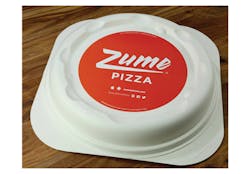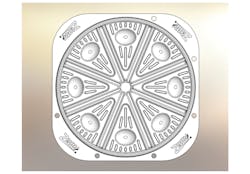Each American eats an average of 46 slices, or 23 lb, of pizza annually. That adds up to three billion pizzas, two billion of which come in cardboard boxes—boxes based on a design that has been around for over 50 years. The owners of Zume Pizza in Silicon Valley thought it was time to rethink the pizza box and make it more environmentally sound. Most importantly, though, it must deliver a much, much better pizza.
The owners knew that cardboard boxes trapped moisture and grease, and they let out too much heat. The trapped steam turns the once-crisp pizza into a soggy mass. And the trapped grease doesn’t help the flavor either. On top of that, together with hardened cheese, the boxes are difficult to recycle. If one or two used boxes make it into a batch of recycled pulp, it lowers the quality of the recovered fiber and can ruin the batch of recycled paper. That’s why many cities ban pizza boxes from recycling programs.
Losing heat through the cardboard boxes means many pizzas must be eaten cold or get a trip through the microwave. So they decided to redesign the box.
The Pizza Pod keeps a pizza hot and crispy, plus it highlights the pizza parlor’s brand with a memorable package.
The first step was going with a round, two-part package. Their employees would no longer have to assemble boxes; just slap a domed top on a fitted bottom holding the pizza and they could deliver them.
Then they added ridges to the bottom portion that were tall enough to keep the pizza out of the oil and grease. Instead grooves would send any liquid to a center circular recess and never touch the pizza crust. The ridges also added stiffness to the bottom piece, so it could be lighter and still strong enough to withstand delivery. Furthermore, the ridges are formed to allow the pizza to be cut into eight same-sized slices when it’s still in the packaging. Not only that, the shaped ridges let the empty package be easily folded up and disposed of, or it can be shaped to hold the leftovers and save space in the fridge.
The bottom of the Pizza Pod includes ridges that make it easy to cut a pizza into eight slices, and recesses that gather and trap any liquids or grease.
The next step was coming up with a suitable material. They eventually settled on sugarcane fiber (also called bagasse), which is what’s left after the juice is squeezed out. It could be molded into the right shapes and strengths, is compostable and recyclable, and takes material out of the waste stream. The finished package weighs 210 grams, lighter than the typical 250-gram cardboard version.
Customers like the improved packaging and so did the judges at this year’s DuPont Awards for Packaging Innovation, where it was named a Diamond Finalist Award Winner. “The Pizza Pod is a unique solution that not only incorporates green materials, but is also able to drive quality in its design,” says David Luttenberger, lead judge for the competition. The aspect that particularly impressed the judges was 100% sustainably farmed sugarcane fiber makes the Pizza Pod “tree-free, compostable and biodegradable.”
Zume also earned nine patents on its design.



